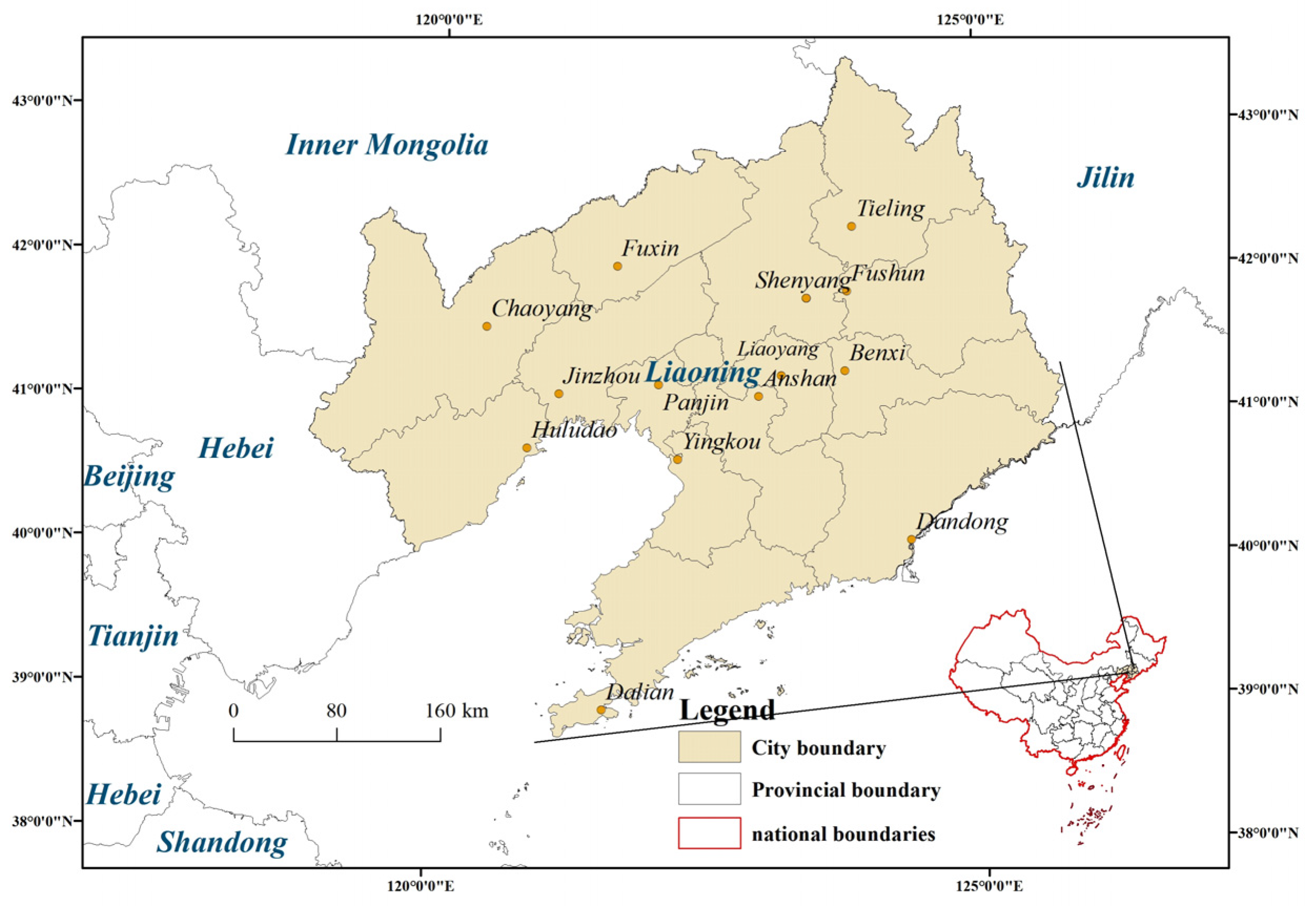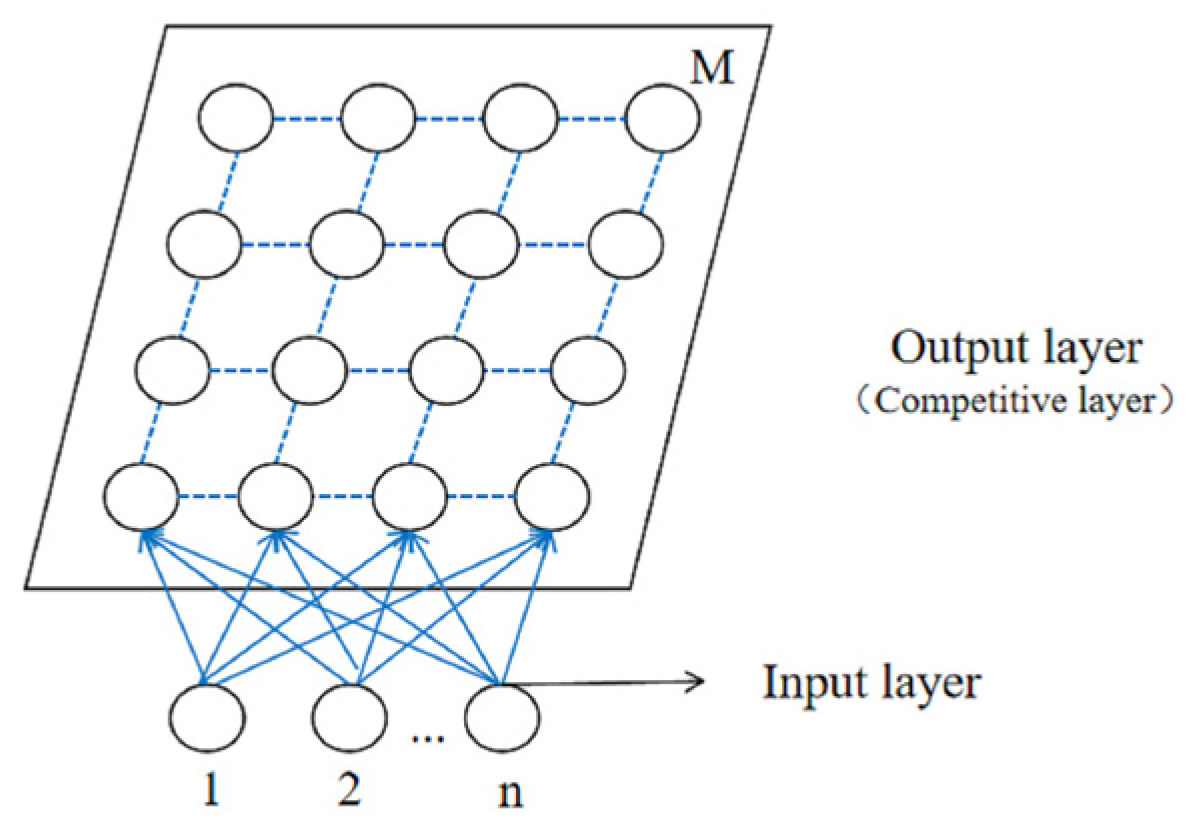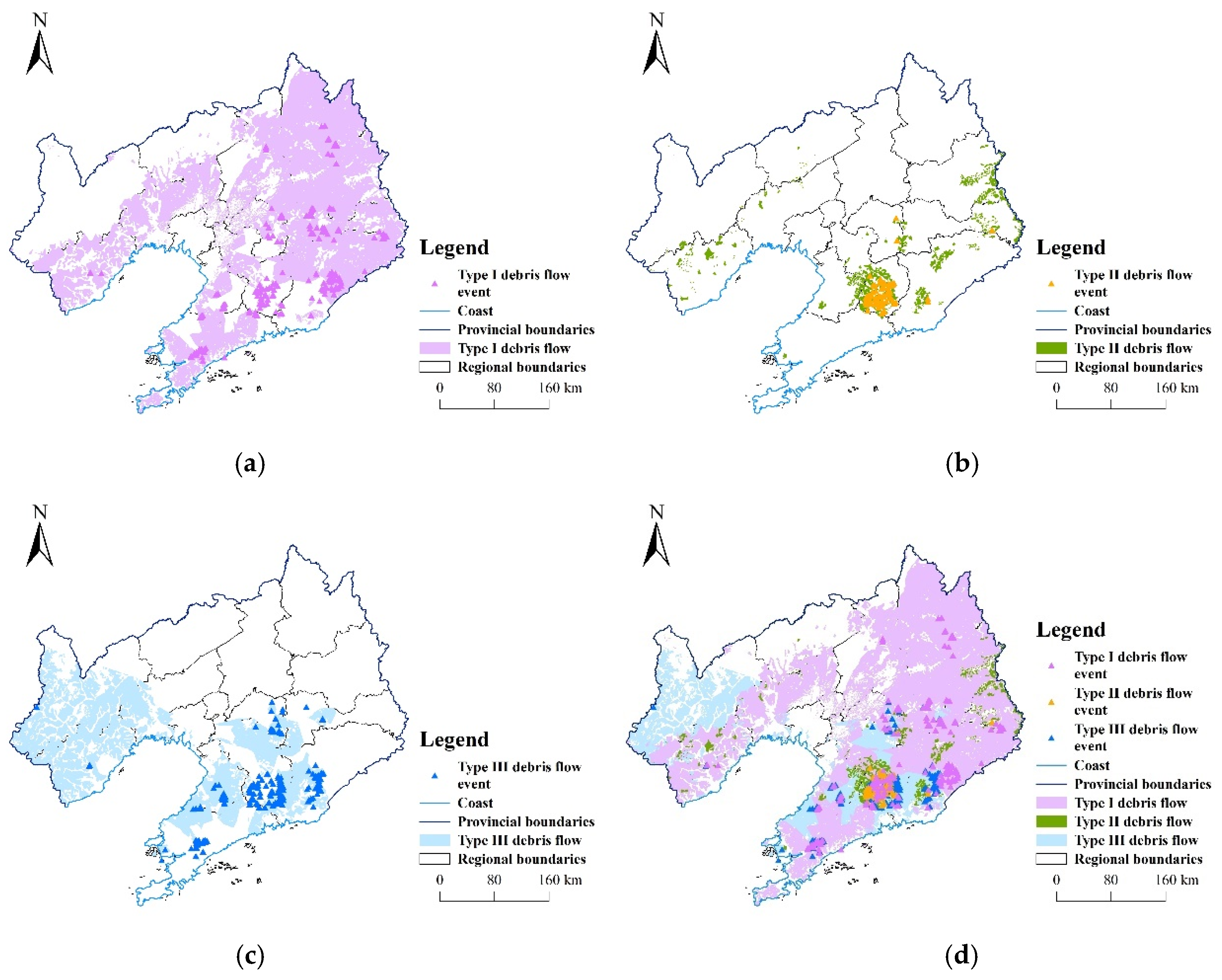Study on the Identification and Classification of Key Influencing Factors of Debris-Flow-Prone Areas in Liaoning Province Based on Self-organizing Clustering and Sensitivity Analysis
Abstract
:1. Introduction
2. Study Area Overview
3. Methods and Data
3.1. Self-Organizing Mapping Clustering Method
3.2. Nonlinear Global Sensitivity Analysis
3.3. Data Source
4. Results and Analysis
4.1. Analysis of Physical and Geographical Characteristics of Debris-Flow-Prone Areas
4.1.1. Influence of Terrain on Debris Flows
4.1.2. Effect of Soil on Debris Flow
4.1.3. The Effect of Vegetation on Debris Flows
4.2. Cluster Analysis of Physiographic Features in Debris-Flow-Prone Areas
4.3. Analysis of Key Physiographic Factors in Debris-Flow-Prone Areas
4.4. Distribution of Debris-Flow-Prone Areas and Prevention and Control Measures
5. Discussion and Conclusions
5.1. Discussion
5.2. Limitation
5.3. Conclusions
Author Contributions
Funding
Institutional Review Board Statement
Informed Consent Statement
Data Availability Statement
Conflicts of Interest
References
- Tian, F.; Ran, Y. Hazard assessment and impact factor analysis of debris flow disasters in Hexi Corridor. J. Nat. Disasters 2017, 26, 139–146. Available online: https://www.cnki.net/kcms/doi/10.13577/j.jnd.2017.0317.html (accessed on 20 October 2022).
- Iverson, R.M. The Physics of Debris Flows. Geophysics 1997, 35, 245–296. [Google Scholar] [CrossRef] [Green Version]
- Shu, A.P.; Tian, L.; Wang, S.; Rubinato, M.; Zhu, F.Y.; Wang, M.Y.; Sun, J.T. Hydrodynamic characteristics of the formation processes for non-homogeneous debris-flow. Water 2018, 10, 452. [Google Scholar] [CrossRef] [Green Version]
- Zhang, G.S. Study on Starting Conditions and Flow Characteristics of Debris Flow; Central University for Nationalities: Beijing, China, 2020. [Google Scholar]
- Zhou, C.H.; Guo, G.B.; Guo, Y.X.; Chen, J.H.; Chen, J.H. Analysis of the causes of mud rock flow in the Xueshan River, Yangbi County, the southeast margin of the Qinghai Tibet Plateau. China Water Transp. 2022, 22, 122–124. [Google Scholar]
- Su, J.D.; Gao, L.B.; Kong, X.; Diao, P.; Gao, N.N. The cause of formation and temporal and spatial distribution characteristics of debris flow in the Bailong River basin. Renmin Changjiang River 2017, 48, 23–25+59. [Google Scholar]
- Panagoulia, D. Assessment of daily catchment precipitation in mountainous regions for climate change interpretation. Hydrol. Sci. J. 1995, 40, 331–350. [Google Scholar] [CrossRef]
- Miller, S.; Brewer, T.; Harris, N. Rainfall thresholding and susceptibility assessment of rainfall-induced landslides: Application to landslide management in St Thomas, Jamaica. Bull. Eng. Geol. Environ. 2009, 68, 539–550. [Google Scholar] [CrossRef]
- Guzzetti, F.; Gariano, S.L.; Peruccacci, S.; Brunetti, M.T.; Marchesini, I.; Rossi, M.; Melillo, M. Geographical landslide early warning systems. Earth-Sci. Rev. 2019, 200, 102973. [Google Scholar] [CrossRef]
- Wang, Y.; Nie, L.; Zhang, M.; Wang, H.; Xu, Y.; Zuo, T. Assessment of Debris Flow Risk Factors Based on Meta-Analysis—Cases Study of Northwest and Southwest China. Sustainability 2020, 12, 6841. [Google Scholar] [CrossRef]
- Aruth. Study on Risk Assessment of Debris Flow Disaster Chain on the North Slope of Changbai Mountain Induced by Multiple Disaster Factors Based on Multi model Coupling; Northeast Normal University: Changchun, China, 2021. [Google Scholar]
- Liu, X.L.; Tang, C.; Zhang, S.L. Quantitative determination method of debris flow risk in mountain valleys of China. Disaster Sci. 1993, 8, 1–7. [Google Scholar]
- Li, G.; Zhao, X.S.; Feng, L.H.; Liang, S.C.; Li, S.; Shi, X.S. Optimization of debris flow prevention scheme based on fuzzy evaluation method—Taking the debris flow in Qinghe County as an example. Chin. J. Geol. Hazards Prev. 2014, 25, 18–23. Available online: https://www.cnki.net/kcms/doi/10.16031/j.cnki.issn.1003-8035.2014.04.005.html (accessed on 20 October 2022).
- Panchal, S.; Shrivastava, A.K. Landslide hazard assessment using analytic hierarchy process (AHP): A case study of National Highway 5 in India. Ain Shams Eng. J. 2022, 13, 101626. [Google Scholar] [CrossRef]
- Shu, H.P.; Liu, D.F.; Gu, C.J.; Zhang, P.; Ma, J.Z. Risk Assessment of Small and Medium Scale Regional Debris Flow Disasters. J. Mt. Sci. 2014, 32, 754–760. [Google Scholar]
- Han, X. Risk Assessment of Debris Flow Disaster in Dongchuan District, Yunnan Province; Southwest Jiaotong University: Chengdu, China, 2018. [Google Scholar]
- Yalcin, A. GIS-based landslide susceptibility mapping using analytical hierarchy process and bivariate statistics in Ardesen (Turkey): Comparisons of results and confirmations. CATENA 2008, 72, 1–12. [Google Scholar] [CrossRef]
- Grelle, G.; Rossi, A.; Revellino, P.; Guerriero, L.; Guadagno, F.M.; Sappa, G. Assessment of Debris-Flow Erosion and Deposit Areas by Morphometric Analysis and a GIS-Based Simplified Procedure: A Case Study of Paupisi in the Southern Apennines. Sustainability 2019, 11, 2382. [Google Scholar] [CrossRef] [Green Version]
- Elkadiri, R.; Sultan, M.; Youssef, A.M.; Elbayoumi, T.; Chase, R.; Bulkhi, A.B.; Al-Katheeri, M.M. A Remote Sensing-Based Approach for Debris-Flow Susceptibility Assessment Using Artificial Neural Networks and Logistic Regression Modeling. IEEE J. Sel. Top. Appl. Earth Obs. Remote Sens. 2015, 7, 4818–4835. [Google Scholar] [CrossRef]
- Yu, M.; Xing, H.G.; Hu, S.Y. Debris flow vulnerability assessment based on information volume logic regression model—Taking Shimian County, Sichuan Province as an example. Renmin Changjiang River 2021, 52, 107–114. Available online: https://kns.cnki.net/kcms/detail/detail.aspx?doi=10.16232/j.cnki.1001-4179.2021.12.016 (accessed on 20 October 2022).
- Zhang, M. Analysis of artificial neural network early warning model of debris flow caused by rainfall. Heilongjiang Water Conserv. Sci. Technol. 2015, 43, 55–56+90. Available online: https://www.cnki.net/kcms/doi/10.14122/j.cnki.hskj.2015.12.020.html (accessed on 20 October 2022).
- Panagoulia, D.; Tsekouras, G.J.; Kousiouris, G. A multi-stage methodology for selecting input variables in ANN forecasting of river flows. Glob. Nest J. 2017, 19, 49–57. [Google Scholar]
- Wu, J.H.; Zhang, C.S.; Yang, W.M.; Meng, H.J.; Guo, H.; Wan, F.P. Risk assessment of debris flow in Zhujiagou Valley based on entropy weight variation coefficient fusion algorithm and FLO-2D. J. Nat. Disasters 2022, 31, 81–91. Available online: https://kns.cnki.net/kcms/detail/detail.aspx?doi=10.13577/j.jnd.2022.0108 (accessed on 7 December 2022).
- Cama, M.; Lombardo, L.; Conoscenti, C.; Rotigliano, E. Improving transferability strategies for debris flow susceptibility assessment: Application to the Saponara and Itala catchments (Messina, Italy). Geomorphology 2017, 288, 52–65. [Google Scholar] [CrossRef]
- Li, B.L.; Wang, C.M.; Li, Y.Y.; Zhang, S.H. Dynamic Response Study of Impulsive Force of Debris Flow Evaluation and Flexible Retaining Structure Based on SPH-DEM-FEM Coupling. Adv. Civ. Eng. 2021, 2021, 90098250. [Google Scholar] [CrossRef]
- Shan, B.; Chen, J.P.; Wang, Q. Sensitivity analysis of debris flow based on minimum entropy theory and unascertained measurement theory. Geotech. Mech. 2014, 35, 1445–1454. Available online: https://www.cnki.net/kcms/doi/10.16285/j.rsm.2014.05.015.html (accessed on 20 October 2022).
- Nikolova, V.; Kamburov, A.; Rizova, R. Morphometric analysis of debris flows basins in the Eastern Rhodopes (Bulgaria) using geospatial technologies. Nat. Hazards 2020, 105, 159–175. Available online: http://link-springer-com-443.beijingjiaoda.tsg211.com/article/10.1007/s11069-020-04301-4 (accessed on 20 October 2022). [CrossRef]
- Liu, Y.; Bai, H.; Wang, H.Y.; Wang, W.B.; Zeng, N. Comprehensive evaluation of debris flow based on sensitivity mapping and numerical simulation—Taking Shaga Valley of Jiujiang Mianyang Expressway as an example. Sci. Technol. Eng. 2021, 21, 9264–9274. [Google Scholar]
- Li, H.Y.; Tian, Q.; Wang, X.J.; Wu, Y.N. Multivariate coupling sensitivity analysis method based on a back-propagation network and its application. J. Hydrol. Eng. 2015, 20, 06014013. [Google Scholar] [CrossRef]
- Li, Q.; Lu, Y.; Wang, Y.; Xu, P. Debris Flow Risk Assessment Based on a Water–Soil Process Model at the Watershed Scale Under Climate Change: A Case Study in a Debris-Flow-Prone Area of Southwest China. Sustainability 2019, 11, 3199. [Google Scholar] [CrossRef] [Green Version]
- Hou, P.L. Development Law and Vulnerability Assessment of Debris Flow in the Upper Reaches of Minjiang River; Southwest University of Science and Technology: Mianyang, China, 2022; Available online: https://www.cnki.net/kcms/doi/10.27415/d.cnki.gxngc.2022.000280.html (accessed on 5 December 2022).
- Wang, C.M.; Tian, S.W.; Wang, Y.H.; Ruan, Y.K.; Ding, G.L. Debris flow risk assessment: Fuzzy c-means clustering support vector machine method. J. Jilin Univ. 2016, 46, 1168–1175. Available online: https://www.cnki.net/kcms/doi/10.13278/j.cnki.jjuese.201604203.html (accessed on 20 October 2022).
- Li, X.; Fan, J.R.; Zhang, J.Q. Application of WKFCM clustering algorithm based on weight in debris flow evaluation. Disaster Sci. 2015, 30, 214–218. [Google Scholar]
- Zheng, S. Spatial Characteristics Analysis and Zoning of Rainfall Induced Debris Flow in Liaoning Province; Liaoning Normal University: Dalian, China, 2018. [Google Scholar]
- Li, H.Y.; Yuan, R.X.; Wang, X.J.; Zhang, L.; Yu, W.Q. Analysis of rainfall characteristics in debris flow prone areas in Jilin Province. J. Nat. Resour. 2016, 31, 1222–1230. [Google Scholar]
- Wei, X.; Zhang, J.; Zhou, H.; Živanović, S. Sensitivity analysis for pedestrian-induced vibration in footbridges. Buildings 2022, 12, 883. [Google Scholar] [CrossRef]
- Yin, G.F.; Zhang, Y.J.; Hu, L.; Yu, S.H.; Xiao, X.; Wang, H.B.; Shi, C.Y.; Duan, J.B.; Liu, W.Q. Sensitivity analysis of BP neural network water bloom prediction model. J. Beijing Univ. Technol. 2012, 32, 1288–1293. [Google Scholar]
- Qiang, D.X.; Ma, H.Z.; Zhu, Z.P.; Gou, Y.M. Spatial Distribution and Analysis of Debris Flow in Jishishan County, Gansu Province. Surv. Mapp. Bull. 2022, 107–111+117. Available online: https://kns.cnki.net/kcms/detail/detail.aspx?doi=10.13474/j.cnki.11-2246.2022.0212 (accessed on 20 October 2022).
- Li, C.X.; Ma, Y.; He, Y.X. Sensitivity analysis of debris flow disaster causing factors—Taking the Longxi River Basin in Dujiangyan, Sichuan Province as an example. Chin. J. Geol. Hazards Prev. 2020, 31, 32–39. [Google Scholar]
- Walter, F.; Amann, F.; Kos, A.; Kenner, R.; Phillips, M.; de Preux, A.; Huss, M.; Tognacca, C.; Clinton, J.; Diehl, T.; et al. Direct observations of a three million cubic meter rock-slope collapse with almost immediate initiation of ensuing debris flows. Geomorphology 2020, 351, 106933. [Google Scholar] [CrossRef]
- Xu, H. Research on the Estimation Model of the Critical Concentration of Loose Solid Matter in Debris Flow. J. Southwest Jiaotong Univ. 1995, 30, 212–217. [Google Scholar]
- Gao, Y.C.; Li, M.H.; Wang, D.H.; Bai, Y.J. Preliminary study on the inhibition of vegetation on different types of debris flows. Res. Water Soil Conserv. 2013, 20, 291–295+299. [Google Scholar]
- Jin, S.G.; Zhu, W.Y. Analysis of Atlantic expansion change based on global plate motion model. Surv. Mapp. Sci. 2002, 1, 32–35. [Google Scholar]
- Zhang, G.X.; Wang, S.G. Preliminary Study on the Ecological Environment of the Xiaojiang River Basin in Dongchuan, Yunnan Province and Protection Countermeasures. Res. Water Soil Conserv. 2006, 13, 50–52. [Google Scholar]
- Hu, J.; Qin, G.H.; Wang, R.Y.; Wang, S.R.; Xiao, H. Numerical simulation of slope surface flow characteristics under different slopes and vegetation coverage. J. Soil Water Conserv. 2022, 36, 37–43. Available online: https://kns.cnki.net/kcms/detail/detail.aspx?doi=10.13870/j.cnki.stbcxb.2022.03.006 (accessed on 20 October 2022).
- Wang, G.Z.; Li, Z.Y.; Cheng, H.L.; Zhang, J.Y.; Gao, J.Q.; Yang, D.; Li, X.H.; Lu, Y.Z. Study on Vegetation Coverage Distribution in Different Slope Zones in Yanshi District. Hubei Agric. Sci. 2022, 61, 106–110. Available online: https://kns.cnki.net/kcms/detail/detail.aspx?doi=10.14088/j.cnki.issn0439-8114.2022.05.020 (accessed on 20 October 2022).
- Cui, C.F. GIS and AHP Based Debris Flow Vulnerability Assessment on Both Sides of Daban Tangwang Section of Taohe River; Henan Polytechnic University: Jiaozuo, China, 2019. [Google Scholar]
- Chen, Z.X.; Wang, R.; Hu, M.J.; Wang, Z.B.; Xu, D.S. Analysis of the impact of clay particle content on the initiation of debris flow in Jiangjia Valley. Geotech. Mech. 2010, 31, 2197–2201. Available online: https://www.cnki.net/kcms/doi/10.16285/j.rsm.2010.07.007.html (accessed on 6 December 2022).
- Cao, Y.Q.; Zhang, R.N.; Li, L.H.; Lu, J.; Ning, Y. Study on the relationship between debris flow and precipitation factors at different time scales in Liaoning Province. Disaster Sci. 2021, 36, 51–56. [Google Scholar]
- Fu, H.C.; Xu, X.C. Evaluation of sensitivity of debris flow to slope. China Water Transp. 2017, 17, 353–355. [Google Scholar]
- Cao, L. Impact of Plateau Vegetation on Debris Flow. Agric. Disaster Res. 2021, 11, 92–93. [Google Scholar]
- Shao, Z.C. Analysis of the impact of vegetation coverage on the development of debris flow. Value Eng. 2017, 36, 151–152. Available online: https://www.cnki.net/kcms/doi/10.14018/j.cnki.cn13-1085/n.2017.10.060.html (accessed on 20 October 2022).
- Peng, R. Comprehensive Exploration and Analysis of Debris Flow Characteristics in Xiaojiang River Basin; Kunming University of Science and Technology: Kunming, China, 2019; Available online: https://www.cnki.net/kcms/doi/10.27200/d.cnki.gkmlu.2019.001484.html (accessed on 5 December 2022).
- Zhang, L. Analysis on the Characteristics of Rainstorm and Flood Induced Debris Flow in Jilin Province; Jilin University: Changchun, China, 2015. [Google Scholar]
- Tian, X.H.; Zhu, H.Y.; Han, J.Y.; Chu, Y.X.; Xue, K.X.; Xu, G.B.; Qi, X.H. Dynamic assessment of rainfall induced debris flow risk. Sci. Technol. Eng. 2022, 22, 5411–5416. [Google Scholar]







| Category | First Species | Second Species | Third Species |
|---|---|---|---|
| Debris flow event | T6, T10, T41, T42, T52…… | T1, T2, T20, T36, T37…… | T0, T3, T4, T5, T7…… |
| Number | 209 | 114 | 215 |
| Clay | 12–29% | 12–16% | 10–19% |
| Sand | 32–54% | 60–70% | 33–66% |
| Silt | 16–38% | 18–32% | 22–38% |
| Slope | <40.84° | 10°–45° | <30° |
| Altitude | 0 m–977 m | 200 m–666 m | 0 m–558 m |
| Land use | Cropland, Forest, Grassland, Water, Impervious | Cropland, Forest, Grassland, Impervious | Cropland, Forest, Grassland, Water, Impervious |
| Landforms | Plain, Platform, Hill, Small undulating mountain, Medium undulating mountain | Plain, Platform, Hill, Small undulating mountain, Medium undulating mountain | Plain, Platform, Hill, Small undulating mountain, Medium undulating mountain |
| NDVI | 0.30–0.59 | 0.36–0.59 | 0.28–0.62 |
| Vegetation | Coniferous forest, Broad-leaved forest, Coniferous Broad-leaved mixed forest, Thicket, Meadow, Cultivated plants | Coniferous forest, Broad-leaved forest, Coniferous Broad-leaved mixed forest, Thicket, Meadow, Cultivated plants | Coniferous forest, Broad-leaved forest, Coniferous Broad-leaved mixed forest, Thicket, Meadow, Cultivated plants |
| Slope direction | 0–360° | 0–360° | 0–360° |
| Soiltypes | Neutral coarse skeletal soil, Meadow soil, Brown loamy soil, Rice soil | Neutral coarse skeletal soil, Meadow soil, Brown Soil, Tidal brown soil, Brown loamy soil, Dark brown soil, Cinnamon soil | Coarse bony soil, Neutral coarse skeletal soil, Meadow soil, Brown Soil, Tidal brown soil, Brown loamy soil, Cinnamon soil, Lakes and Reservoirs |
| Category | First Species | Second Species | Third Species |
|---|---|---|---|
| Clay | 0.986 | 0.992 | 0.792 |
| Sand | 0.726 | 0.891 | 0.981 |
| Silt | 0.831 | 0.811 | 0.625 |
| Slope | 0.768 | 0.644 | 0.647 |
| Altitude | 0.707 | 0.681 | 0.636 |
| Land use | 0.668 | 0.746 | 0.778 |
| Landforms | 0.666 | 0.703 | 0.706 |
| NDVI | 0.622 | 0.686 | 0.616 |
| Vegetation | 0.434 | 0.592 | 0.527 |
| Slope direction | 0.290 | 0.578 | 0.32 |
| Soil types | 0.502 | 0.494 | 0.406 |
Disclaimer/Publisher’s Note: The statements, opinions and data contained in all publications are solely those of the individual author(s) and contributor(s) and not of MDPI and/or the editor(s). MDPI and/or the editor(s) disclaim responsibility for any injury to people or property resulting from any ideas, methods, instructions or products referred to in the content. |
© 2022 by the authors. Licensee MDPI, Basel, Switzerland. This article is an open access article distributed under the terms and conditions of the Creative Commons Attribution (CC BY) license (https://creativecommons.org/licenses/by/4.0/).
Share and Cite
Wang, F.; Cao, Y.; Fan, S.; Zhang, R. Study on the Identification and Classification of Key Influencing Factors of Debris-Flow-Prone Areas in Liaoning Province Based on Self-organizing Clustering and Sensitivity Analysis. Sustainability 2023, 15, 412. https://doi.org/10.3390/su15010412
Wang F, Cao Y, Fan S, Zhang R. Study on the Identification and Classification of Key Influencing Factors of Debris-Flow-Prone Areas in Liaoning Province Based on Self-organizing Clustering and Sensitivity Analysis. Sustainability. 2023; 15(1):412. https://doi.org/10.3390/su15010412
Chicago/Turabian StyleWang, Fei, Yongqiang Cao, Shuaibang Fan, and Ruoning Zhang. 2023. "Study on the Identification and Classification of Key Influencing Factors of Debris-Flow-Prone Areas in Liaoning Province Based on Self-organizing Clustering and Sensitivity Analysis" Sustainability 15, no. 1: 412. https://doi.org/10.3390/su15010412




